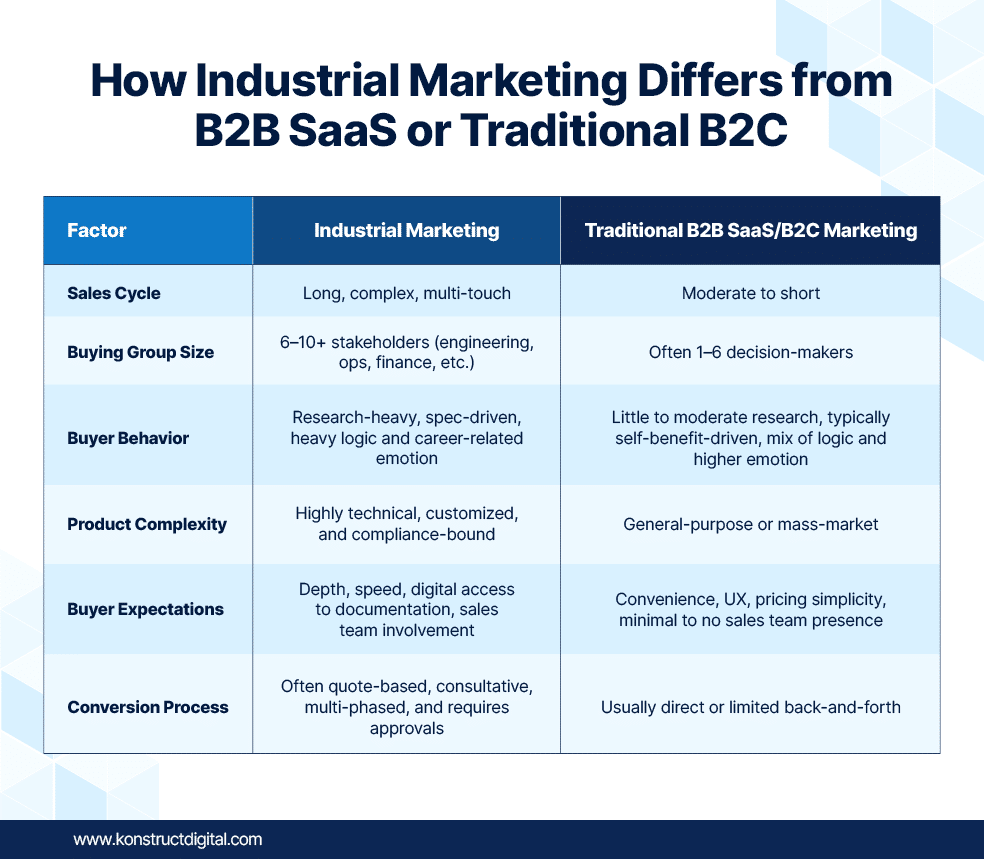Table Of Contents
- Why Industrial Marketing Needs a New Playbook
- What Is Industrial Marketing Strategy?
- The Times Are A-Changin’
- Foundational Building Blocks of a Smart Industrial Marketing Strategy
- 6 Pillars of a Modern Industrial Marketing Strategy
- Conclusion: Industrial Doesn’t Mean Outdated
- Ready to Build a Smarter Industrial Marketing Engine?
Why Industrial Marketing Needs a New Playbook
Industrial marketing isn’t what it used to be. And we believe that’s a good thing.
Today’s industrial and manufacturing buyers aren’t waiting for a sales call. They’re self-educating through technical spec sheets, case studies, peer reviews, and digital demos; often before your brand even knows they’re in-market. That reality has fundamentally changed how marketing must show up.
At the same time, buying groups are growing. Where once a purchasing manager might make the call, today’s decisions are shaped by 6–10 stakeholders across engineering, operations, procurement, finance, and even sustainability teams. And as new generational cohorts, such as Millennials and Gen Zs, step into roles of influence, expectations shift again: speed, clarity, and digital-first experiences aren’t nice-to-haves—they’re table stakes.
It’s time for industrial brands to stop marketing like it’s 2012.
This article is your updated blueprint. Whether you’re in chemicals, manufacturing tech, construction materials, or heavy industry services, we’ll walk you through the strategies, technologies, and trends you need to acknowledge to meet modern buyers where they are, and guide them toward action.
Let’s build a smarter industrial marketing strategy—starting now.
What is Industrial Marketing Strategy?
(And Why It’s Not Just B2C with a Hard Hat)
At its core, industrial marketing strategy refers to the structured planning and execution of marketing efforts for industrial companies that produce, distribute, or support industrial goods and services, ranging from raw materials and machinery to manufacturing tech and logistics solutions.
It sounds straightforward on the surface, but treating industrial marketing as you would other company models, such as B2C or B2B SaaS, doesn’t cut it.
While industrial marketing shares DNA with other B2B strategies, it brings a level of complexity and nuance that most traditional approaches fail to address. The products are technical, the buyers are analytical, and the path to purchase is rarely linear.

Modern industrial buyers want clarity and confidence, and they’re no longer waiting on, or wanting, for that matter, a sales rep to guide the way.
The Times Are A-changin’
Differences between industrial marketing, B2C, and other B2B SaaS aside, the impacts of recent events like digital transformation, global supply chain volatility, shifting buyer expectations and demographics, and behaviours have played out as noteworthy trends across all of modern B2B marketing. These trends and their impact on industrial B2B marketing have shone through in a few undeniable ways.
The Rise of the Self-guided Buyer
Today’s industrial buyers conduct 73% of their journey before ever speaking to sales (GreenHat). They browse technical specs at night, download white papers between site visits, and vet vendors based on online credibility—all without raising a hand.
That means your brand must be findable, educational, and trustworthy from the moment curiosity strikes—because you may never get a second chance to make a first impression. In fact, studies show that up to 90% of B2B buyers select a vendor from a ‘Day‑One Shortlist’ (LinkedIn)—brands they knew before starting active research.
The Expanding Buying Group
Gone are the days when a single plant manager or purchaser could greenlight a deal. Industrial buying decisions now involve a web of internal stakeholders, each with their own priorities:
- Engineers care about performance and compatibility
- Maintenance teams focus on reliability and uptime
- Procurement prioritizes pricing and delivery terms
- Finance looks for ROI and cost of ownership
- Sustainability teams scrutinize ESG compliance
- And executives want long-term impact and risk mitigation
According to the 2024 Buyer Experience Report by 6sense, the average B2B buying group now consists of 11 people, with many buyers already knowing their preferred vendor and requirements before contacting sales. In response, a robust multi-threaded marketing strategy is often required to effectively reach your buying group’s members, or you risk being vetoed by one.
A New Generation of Decision-Makers
Millennials now dominate industrial buying roles, and Gen Z is right behind them. These are digital-native cohorts who expect:
- Seamless online experiences
- Mobile-optimized product data
- Clear, accessible pricing
- Case studies that speak to their industry and use case
- Social proof and peer validation
Forrester’s 2023 survey found that Millennials and Gen Z now make up 71% of B2B buying decisions, signalling a fundamental shift in buyer expectations, preferences, and behaviors. If your website feels like a 2005 product catalog, or if your content strategy doesn’t address modern buyer behavior, you’re likely being filtered out before the conversation even starts.
Foundational Building Blocks of a Smart Industrial Marketing Strategy
Before you launch a campaign or choose a tech stack, you need a foundation that aligns your efforts with how industrial buyers actually think, behave, and progress in their respective buying journeys.
Here are the six strategic elements top-performing industrial brands are building into their marketing engines from day one:
1. Define Your Ideal Customer Profile (ICP)
Not all potential buyers are created equal. Your Ideal Customer Profile is a data-backed definition of the types of companies most likely to convert, stay loyal, and generate long-term value. This foundational component is possibly the most important. If you aren’t reaching out to the most ideal prospects, you could be setting yourself or other members of your go-to-market team up for failure.
For industrial businesses, an ICP definition might include:
- Industry vertical (e.g., food processing, oil & gas, automotive supply chain)
- Facility or fleet size
- Equipment compatibility or compliance standards
- Geographic reach and logistics needs
- Buying group dynamics (Who’s typically in the room?)
Pro Tip: Map your ICP against “Day‑One Shortlist” thinking. If buyers don’t know to consider your brand when a need arises, you may never even enter the conversation.
2. Map the Buying Group, Not Just the Buyer
As noted earlier, buying groups are expanding—now often reaching 10 or more stakeholders, each with different priorities. Complicating matters further, ~50% of the buying group consists of hidden buyers (Green Hat), operating behind the scenes but still essential to deal success.
To market effectively, you need to:
- Identify common roles associated with buying decisions (engineering, ops, procurement, finance, sustainability). Identify hidden and target buyers. Conversations with your existing customers and sales team will provide great insights.
- Understand what each role cares about (specs, uptime, cost, ESG, ROI)
- Anticipate the objections and friction points they may introduce, and create content to get ahead of being written off early in the buying process
Pro Tip: Build a messaging matrix with buyer journey stages on one axis and stakeholder roles on the other. Align content and messaging to each intersection.
3. Persona-based Content and Messaging: Rational Meets Human
Engineers need data. Procurement needs numbers. Execs need business cases. But all of them are human and can play an equally important role in your buying group.
A strong strategy doesn’t just inform—it resonates. That means addressing:
- Functional pain (“We’re losing 12 hours a week to manual reporting…”)
- Business impact (“That’s costing $40K a month in lost productivity…”)
- Personal payoff (“I want to be the one who improves our operation.”)
Pro Tip: Create tailored messaging that “tracks” for technical, economic, and executive personas, each with its blend of emotional and rational motivators.
4. Identify Category Entry Points (Ceps)
Even in long sales cycles, buyers don’t come out of nowhere. They start exploring after specific triggers, known as Category Entry Points (CEPs). Understanding the buyer’s journey and identifying the trailhead is beyond valuable information. These might include:
- Equipment failure or warranty expiration
- Regulatory changes or compliance gaps
- Plant expansions or process upgrades
- Vendor dissatisfaction or contract changes
- New leadership or ESG mandates
Pro Tip: Your job is to be discoverable and helpful when those triggers fire. That means distributed and discoverable content, product resources, and thought leadership tailored to those moments.
5. Understand the Buying Journey (Not Just the Funnel)
Forget your old funnel diagrams. Industrial buying doesn’t follow a straight line, it loops, stalls, and restarts as priorities shift and new stakeholders get involved.
A modern strategy is built around how decisions actually happen:
- Awareness kicks off from a trigger event (a failure, expansion, or compliance need)
- Self-guided research dominates the early phases, often before sales is even aware
- Cross-functional collaboration in the buying group introduces conflicting priorities and internal debates
- Consensus building slows things down—unless friction can be removed
- Potential vendor engagement comes late, often just to validate or compare
- Purchase execution requires finance, legal, and operational readiness
Pro Tip: You want to reduce friction within the journey by giving each stakeholder what they need to move forward. That includes spec sheets, calculators, ROI models, regulatory references, and social proof. Success means enabling smarter decisions across the buying group, not just generating leads at the top.
6. Lay the Groundwork for Scalable Data Architecture
Even the best messaging won’t work if your systems can’t deliver it to the right people or prove it’s working.
To support a high-performing industrial marketing strategy, your data architecture must:
- Unify CRM, MAP, and website behavior data
- Track engagement across buying groups, not just individuals
- Segment accounts by lifecycle stage, vertical, region, or product fit
- Trigger the right message at the right time (e.g., post-demo follow-ups, pricing prompts)
- Attribute impact across channels to optimize performance
- Create and track a host of intent signals to inform marketing’s influence
Pro Tip: A solid data founding is no longer a nice-to-have, it’s paramount to success. Think of this as the nuts and bolts that hold your marketing engine together, largely invisible to buyers, but mission-critical for scale, personalization, and ROI reporting.
6 Pillars of a Modern Industrial Marketing Strategy
With your strategic foundation in place, the next step is execution—bringing your strategy to life across touchpoints, tools, and channels that reflect how industrial buyers research, compare, and commit.
Below are the six key pillars that top-performing industrial marketing teams rely on to generate visibility, influence buying groups, and accelerate revenue.
1. Content Marketing Engine: Build Trust Before the First Conversation
In an industry where purchases carry high risk and long-term implications, content is often the first and only salesperson during early research. Use your content to build a case for your offering in a helpful way that your buyers will appreciate.
Your content should:
- Educate the technically inclined with spec sheets, CAD files, and comparison guides
- Build credibility with case studies, white papers, and demo videos
- Speak to the numbers people with ROI calculators, efficiency benchmarks, and total cost of ownership models
- Equip procurement with implementation timelines, warranty info, and delivery expectations
Content Types to Prioritize:
- Technical blog posts
- Application-specific landing pages
- Industry-focused white papers
- Webinar replays + product walkthroughs
- Peer validation (testimonials, customer quotes, third-party reviews)
Pro Tip: Create modular content pieces so a single topic can be repackaged for multiple personas, journey stages, and distribution channels.
2. Search, SEO, and GEO: Get Found at the Category Entry Point
If you’re not showing up when buyers search or consult with LLMs, like ChatGPT, you could find yourself out of the running. To take that a step further, you need to be present when accounts establish their Day-One Shortlist. Showing up later in the journey makes things more challenging and can be a case of too little, too late.
Industrial SEO and GEO isn’t just about keywords, it’s about owning intent across:
- Long-tail technical phrases (“best replacement for [Part ID] in corrosive environments”)
- “How-to” and troubleshooting queries
- Category-level comparison searches (“[Brand A] vs [Brand B] flow meters”)
- Use-case or industry-specific solutions (“flow sensors for dairy processing”)
Key Search Engine Optimization Strategies:
- Build landing page and article content clusters around pain points and applications
- Optimize for schema and technical product data
- Use AI tools to identify underserved long-tail opportunities
- Ensure your site structure supports fast access to product-level data
Pro Tip: Future-proof with GEO (generative engine optimization). According to Forrester’s research 87% of B2B buyers now leverage AI in their purchase process. Showing up here may be the confirmation buyers need to pull the trigger.
3. Paid Media & ABM: Reach the Right Buyers at the Right Moment
Organic takes time, sometimes more than your sales team can afford. Additionally, it’s challenging to penetrate the market with precision organically. That’s where paid channels and Account-Based Marketing (ABM) come in.
Effective ABM combines explicit targeting with high-value content to influence key stakeholders across specific accounts.
Paid Tactics That Work in Industrial:
- LinkedIn role-based targeting by firmographics, job function, seniority, and industry. This should reflect your ICPs
- Retargeting by product category or content downloads
- Sponsored content and remarketing in trade publications
- Geo-fencing applicable tradeshows with brand or demand generation messaging
Pro Tip: Don’t just promote gated white papers. Promote tools, calculators, case studies, testimonials, and reports; things that shorten the buyer’s internal research process. Treat paid campaigns as tests; it’s challenging to know what will work with your audience and what won’t until you try.
4. Website UX & Conversion Strategy: Make it Easy to Buy in
Your website isn’t just a digital brochure; it’s your best sales rep and most scalable buying assistant. Or, at least it should be.
For industrial buyers, your site must:
- Surface spec data and part numbers fast (preferably searchable or filterable)
- Include rich product detail (certifications, CAD files, pressure ratings, etc.)
- Support buyer enablement (quote tools, sample request forms, ROI calculators)
- Be optimized for mobile (especially field access)
- Guide different personas to what they need without friction
CRO Tactics to Test:
- Industry-specific landing pages
- Sticky sidebars with tech specs
- Persistent CTAs for engineers and procurement
- Chatbots programmed with industrial buyer FAQs
- CTA strategy for early and late-journey buyers
Pro Tip: Run usability testing with 5 real members of your target audience and ask them to perform desirable actions. Detail their challenges and points of friction.
5. Marketing Technology & Data Architecture: Turn Insight into Action
Now’s the time to activate the data foundation we discussed earlier. Martech doesn’t win deals alone, but it enables everything that does.
Martech Essentials for Industrial:
- CRM (e.g., HubSpot, Salesforce) to align sales and marketing
- Marketing Automation (e.g., Marketo, Pardot) to run nurtures and workflows
- CDP or analytics platform to stitch journey data together
- Attribution modelling to tie content and campaigns to revenue outcomes
- ABM platforms (e.g., ZoomInfo, 6Sense, Demandbase) to identify in-ICP traffic and help identify qualified buying groups
Pro Tip: Track early signals like tool use, downloads, spec page visits, or team-wide website activity to identify active accounts earlier.
6. Brand: Get on the Shortlist Before the Buying Journey Begins
Brand is often undervalued in industrial marketing, but it plays a decisive role in who makes the Day-One Shortlist, and ultimately, wins the purchase at the end of the day. Don’t make the mistake and allow murky attribution result in a weak brand. Per the B2B Institute, 46% of your marketing budget should be dedicated to brand-building efforts.
Studies show:
- Up to 92% of B2B buyers choose from a shortlist of vendors they were already aware of at the start of their research (Bain & Co., LinkedIn B2B Institute)
- Around 84% of buyers ultimately go with the first vendor they speak with (6sense)
In industrial markets, where switching costs are high and products are complex, buyers don’t have time to vet dozens of unknowns. Instead, they default to familiar brands they associate with trust, competence, and relevance.
A strong brand:
- Builds mental availability (“I’ve heard of them before”)
- Positions your company as a safe, credible, low-risk choice
- Accelerates trust among internal stakeholders in the buying group
- Improves win rate and pricing power—even when competitors have similar offerings
Industrial Branding in Practice:
- Invest in category leadership content (not just product promotion)
- Amplify customer success stories with video, testimonials, and reviews
- Sponsor industry events, webinars, or training series that reinforce expertise
- Inject brand messaging into your paid media mix, targeting your TAM for desired coverage
- Maintain brand consistency across all channels—from technical sheets to trade show booths
Pro Tip: Monitor metrics like share of search, direct traffic, branded search volume, organic search CTR, and sales cycle length as proxies for change in the brand’s salience and impact. Or, if budget permits, consider running brand lift surveys to add clarity.
Conclusion: Industrial Doesn’t Mean Outdated
Industrial buyers and their buying journey have changed, and so must your approach to marketing to them.
Buyers are self-guided, brand-influenced, and highly collaborative. They expect more than specs and trade show booths. They expect digital clarity, trusted expertise, and timely relevance—before you even know they’re looking.
A modern industrial marketing strategy isn’t just about generating leads. It’s about:
- Positioning your brand for Day-One Shortlists
- Influencing buying groups, not accumulating MQLs
- Showing up with answers and guidance early in the buying process
- Proving value before price even enters the conversation
- Empathizing with your buyers and making the decision-making process easier for them
That requires a commitment to building strong foundations, tight execution across the six pillars, and a commitment to continuous learning, because what works today may not tomorrow.
If your current strategy feels like it’s built for a different era, it probably is.
Ready to Build a Smarter Industrial Marketing Engine?
Whether you’re evolving your marketing function, modernizing your brand, or working to align fragmented efforts across teams, it all starts with a clear strategy rooted in how your buyers really buy.
At Konstruct, we use a proven framework called GTR (Go-to-Revenue) to help industrial and manufacturing brands turn strategy into measurable pipeline growth.
If anything in this article resonated, we invite you to explore GTR:
- What it is.
- Why it matters.
- And how to execute it within your organization.
Contact us to explore the framework more and discover how we’re helping industrial B2B teams like yours move from marketing activity to revenue impact.
Need help with B2B Digital Marketing?
Learn more about Konstruct's B2B Digital Marketing Services
More B2B Digital Marketing Resources
- B2B Marketers: Stop Choosing Between Demand Gen, Demand Capture, and Brand
- B2B Manufacturing Marketing That Actually Works in 2025
- Proving Marketing’s Value in 2025 for B2B
- Perform This 1 Exercise to Increase Your Close Rates and Drive Revenue Lift
- Should You Be Doing CRO for Your B2B Website?
- How to Set Your Marketing Agency Up for Early Success
- Your B2B Go-to-Market Strategy Is Failing: 10 Red Flags You Can’t Ignore
- The *Definitive* 8 Best Manufacturing Marketing Agencies in North America [2025 Edition]
- Don’t Panic: How to Diagnose Dropping B2B Marketing Metrics
- The Top 3 Digital Marketing Opportunities for Manufacturers in 2025


